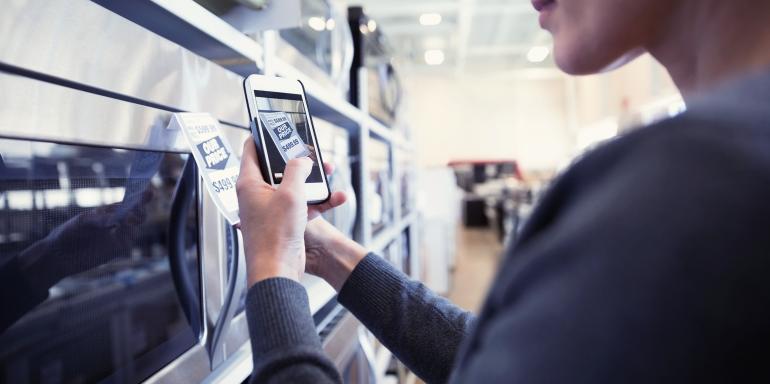With the help of 2.14 billion consumers, the ecommerce industry is expected to generate $4.88 trillion in the year 2021:
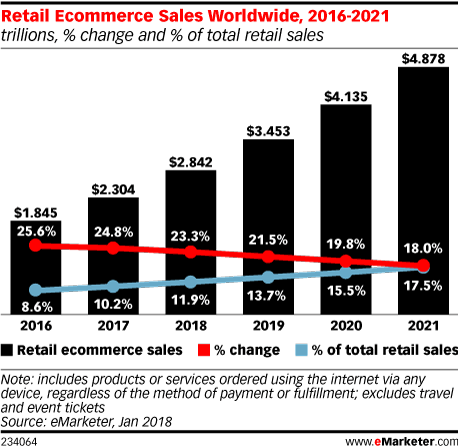
In the meantime, though, the ecommerce industry seems volatile: B2B struggles, mobile adapts, retail grows and the future involves some new-age tech. Here’s a look at some recent ecommerce trends you should know:
Ecommerce trends for 2019 and beyond
B2B trends
It’s a commonly held belief that ecommerce businesses are all B2C; however, there’s recent data to show that not only is that untrue but that the B2B ecommerce sector is growing rapidly.
Today, 75% of the B2B buying process takes place online. And according to one report, B2B ecommerce may even outearn B2C ecommerce within the next few years.
Despite its expected boom, Econsultancy claims that, currently, B2B ecommerce businesses struggle to meet consumer expectations:
The fact that a quarter of B2B buyers said they “want easier and faster checkout, easy repeat ordering, quicker delivery and improved tracking” suggests that a still sizable percentage of B2B vendors aren’t offering an optimized buying experience like the ones that consumers have come to expect from B2C.
But, providing this optimized buying experience is often tougher for B2B ecommerce businesses, based on the complexity of the journey to sale. Specifically, faster checkout, easier ordering and beyond — these are aspects of the post-click landing page — an area that many B2B ecommerce brands have only become recently acquainted with.
The post-click landing page describes the point after a prospect clicks an advertisement. As opposed to the pre-click stage — in which the goal is to compel a visitor to click your ad — in the post-click stage, the goal is to get the visitor to convert.
Contributing to that goal are factors like load time, usability, copywriting, message match, etc. It’s easy to see why this stage is getting more attention from marketers when you consider:
- Only 2.81% of ecommerce search ads convert
- Only .59% of ecommerce display ads convert
- Consumers demand a more optimized shopping experience similar to B2C
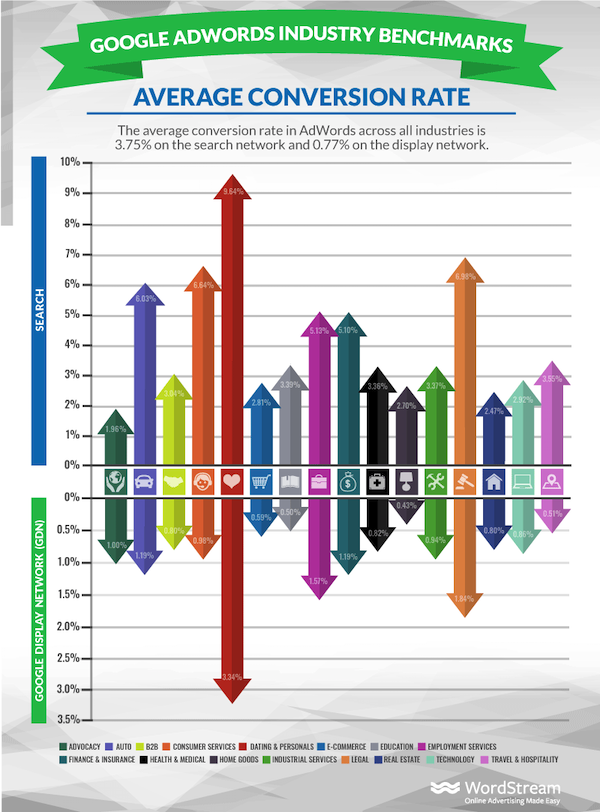
A new trend called post-click automation attempts to improve this. Post-click automation uses scalability, personalization, and optimization to help marketers create an optimized post-click landing page for each ad.
Currently, many ecommerce brands create a handful of landing pages and drive all their campaign traffic there. This often results in poor user experience, though. Each ad campaign is not always relevant to the post-click landing page.
When a business searches “standing desks,” for example, and see an ad for standing desks on Google, that ad should direct the visitor to a post-click landing page for standing desks — not for desks, or office furnishings, or worse: the homepage.
Now, post-click automation platforms help ecommerce brands match the personalization of their ads by meeting individual customers’ needs with personalization and relevance, therefore increasing conversion rate.
Retail trends
Many imagine a world in which ecommerce and retail cannot exist together — the rise of online must mean the fall of offline, right?
Not true.
While some major brick-and-mortar chains have closed their doors, many have adapted to the online landscape. And they’re doing more than just staying afloat. They’re thriving.
Take the furniture brand IKEA, for example. IKEA, known for its massive, meandering warehouses and imaginative showcases, has used modern tech to turn furniture shopping into an activity that can be done online, confidently.
With an app powered by virtual reality, the company’s customers can decorate their homes without ever leaving them. Simply open the app, aim at the area you want to furnish, and select from a catalog of furniture to place.
The app, called Place, will show you what your room will look like with the chosen furniture in it. Later in 2019, IKEA plans to roll its capabilities into one app that enables customers to search designs, choose from room sets, and buy easily from the comfort of their home.
Apps like these move retailers toward the goal of creating an omnichannel experience — a strategy they’re are finding increasingly valuable. Instead of offering siloed experiences across many channels, touchpoints, devices, the omnichannel strategy offers a continuous experience from everywhere in the buyer’s journey.
According to one study of a nationwide retailer’s 46,000 customers:
- 7% shopped only online
- 20% shopped only in-store
- 73% shopped using multiple channels
Shoppers that used multiple channels also spent an average of 4% more in-store and 10% more than single-channel customers. And the more channels a customer shopped on, the more they were likely to spend.
But a true omnichannel experience is very difficult to achieve. Recent research shows that the average retailer is only 52% capable of achieving omnichannel:
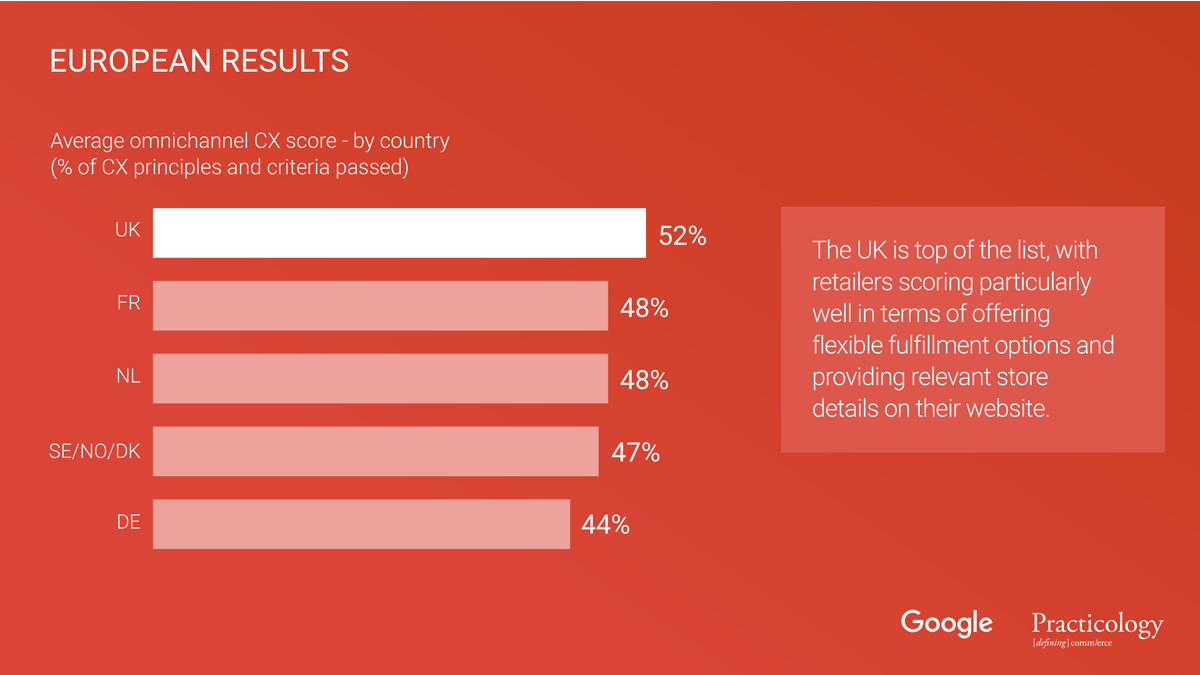
Even the best retailers offer only a 70% omnichannel experience. Still, they’re getting closer, and claiming more of global ecommerce revenue in the process.
Mobile trends
In 2018, mobile sales increased by 55%. This year mobile ecommerce is expected to account for 67.2% of digital sales, and by 2021, that number is expected to reach nearly 73%.
Even though it’s been years since mobile surpassed desktop as the leading source of internet traffic, it’s clear the channel is just getting started.
This surge has been powered by the convenience of mobile and its improving ease of use. Still, though, barriers keep it from performing at its peak: slow load times and lack of accessibility are two of the biggest. Two emerging trends attempt to solve that:
- Progressive web apps: On mobile, the majority of users spend their time in a select few apps: most of which are for social networking. When it comes to shopping, few ecommerce websites have their own apps, and even fewer shoppers have downloaded them. This is where progressive web apps come in.
Progressive web apps are a hybrid of native apps and web applications. They have the reach and discoverability a web page and the ease of use and versatility of a native app. These progressive web apps can be added to the home screen of a phone, just like a native app, but they don’t require a download from a dedicated store. When opened, they behave in almost the same way as native apps. While they’re still limited in their capabilities compared to native apps, that’s changing for the better as time goes on.
- Accelerated Mobile Pages (AMP): AMP is an open-source framework that allows developers to build near instant-loading pages with a lightweight version of traditional code. Since slow load times are one of the greatest killers of mobile conversion rate, these have been widely taken advantage of. Now, there are countless pages built with AMP, and its adoption is only increasing with its versatility. Where once AMP could only accommodate static pages, it’s now a tool that can be used to build landing pages, entire websites, and even progressive web apps.
Together, both promise to solve the ecommerce industry’s slow and difficult browsing experience on mobile.
Future trends
With developments in modern tech like AR and AI, marketing is set to take a futuristic turn. Piers Thorogood, co-founder of ecommerce agency WeMakeWebsites, thinks it will happen this year:
With tools like 'Shopify AR powered by 3D Warehouse' and a growing number of 3D modeling experts, it's become extremely easy to integrate AR into ecommerce stores,” he says. “For consumers, this means a much richer buying experience, allowing them to 'test out' homeware products within their homes and 'try on' clothes and accessories. For merchants, this means higher conversion rates and fewer returns. We're expecting several of our clients to be experimenting with this over the next 12 months.
Indeed, this means tools like IKEA’s “Place” will become more common. So will other service tools, like chatbots, which are becoming increasingly complex and capable for use in the ecommerce industry. When polled on the benefits of chatbots, both millennials and baby boomers saw a lot of promise:
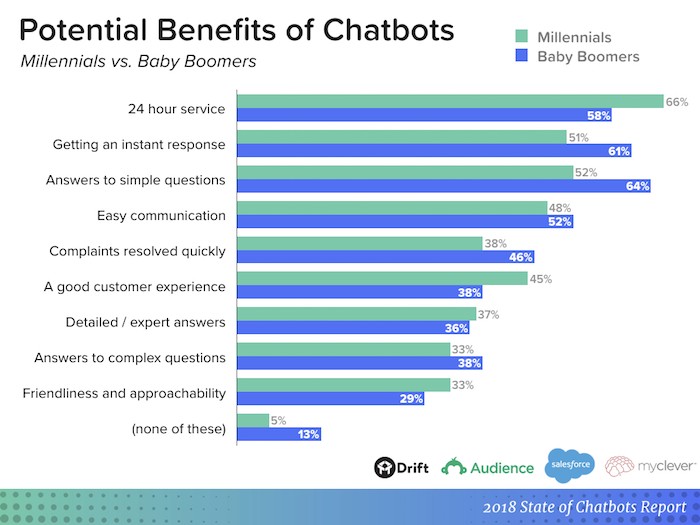
It’s for these reasons that over two-thirds of millennials say they’d be willing to purchase from a chatbot:
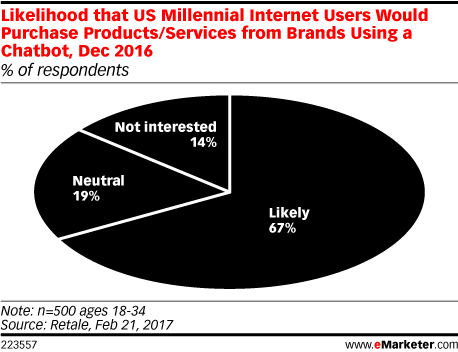
And where consumers get speedy service, businesses get additional resources. Chatbots and other AI assistants can process many tasks that are normally assigned to a human — like managing inventory and basic inquiries. They also have the potential to learn from their interactions, making them more efficient the more they handle.
How will you plan for these ecommerce trends?
Whether it’s with new tech like AR, AI, or AMP — or new strategies like omnichannel marketing and post-click automation — ecommerce is launching into an exciting future. These trends should help you navigate it, boldly. To learn more about valuable optimization trends you may have missed out on, sign up for an Instapage Enterprise demo.
